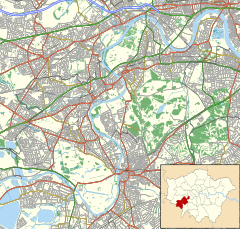Langham House, Ham
| Langham House | |
|---|---|
 Langham House | |
| General information | |
| Status | Completed |
| Type | house |
| Architectural style | Georgian |
| Location | Ham Common, London |
| Address | TW10 7JE |
| Country | England |
| Coordinates | 51°26′1.66″N 0°18′32.95″W / 51.4337944°N 0.3091528°W |
| Completed | 1709 |
| Technical details | |
| Material | stock brick |
| Floor count | 3 |
Listed Building – Grade II | |
| Official name | Langham House |
| Designated | 10 January 1950 |
| Reference no. | 1080830 |
Langham House is a Grade II-listed house facing Ham Common in the London Borough of Richmond upon Thames. It was built in about 1709 and former home of several notable residents.[1]
Location
Langham House is located on Ham Street, on the west side of Ham Common in Ham, London. It is adjacent and to the north of the Grade II-listed Cassel Hospital.
Description
Langham House is a three-storey house with cellar, built of stock brick, five sash windows wide. It has stucco corbel cornice below the parapet and a Doric porch. It has a single-storey and one window wide wing to the right which has a side door with a rusticated stone surround and pediment.[1] Langham Cottage, adjacent to the north, completely rebuilt in 1974, was originally the coach house.[2]
History
Langham House dates from about 1709. It has had several notable former residents during its three-century history.
George Hay, 7th Marquess of Tweeddale lived at the house between 1780 and 1790.[2]
Charles Edgeworth, half-brother of Irish author Maria Edgeworth, resided at the house in 1851. Active within the parish, along with his neighbour, Gordon Forbes, he was involved in the management of the National Orphan Home on other side of the Common.[2]
Air Vice-Marshal, Philip Game resided at the house in 1937.[2]

The property, like many in the area, was part of the
After Lyonel's death at the house in 1953, the house and garden were sold separately, Langham House was converted from a single dwelling into flats and the garden plot was sold for development on a 999-year lease in 1955.[2][5] The land to the south of the house became the access road for the Grade II*-listed Langham House Close development, designed by Stirling and Gowan in 1956; this was built on the garden plot behind the house, between 1957 and 1958, and is considered an exemplar of Brutalist architecture.[6][7][8]See also
References
- ^ a b c Historic England (10 January 1950). "Langham House (1080830)". National Heritage List for England. Retrieved 19 July 2015.
- ^ ISBN 978-0-9563244-0-5.
- ISBN 9780571265930.
- ISBN 9781108036160.
- ISBN 9781955071727.
- ^ Historic England (22 December 1998). "1–18 Langham House Close (1033380)". National Heritage List for England. Retrieved 22 July 2015.
- ^ Historic England (23 December 1998). "19–24 Langham House Close (1033381)". National Heritage List for England. Retrieved 22 July 2015.
- ^ Historic England (22 December 1998). "25–30 Langham House Close (1051027)". National Heritage List for England. Retrieved 22 July 2015.

